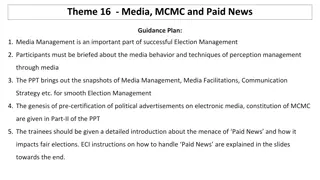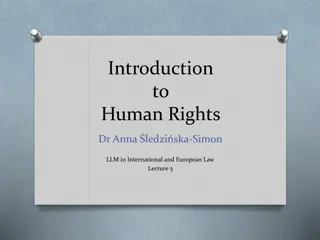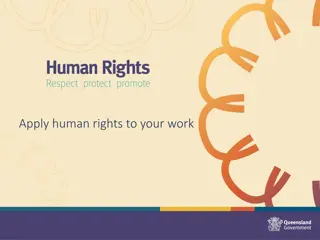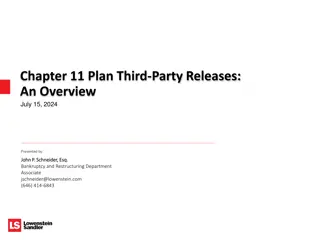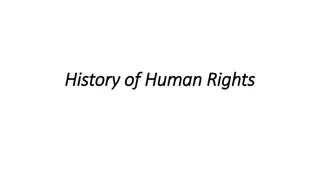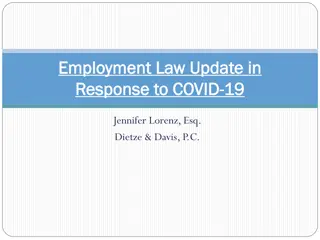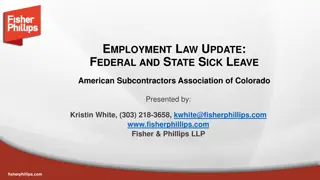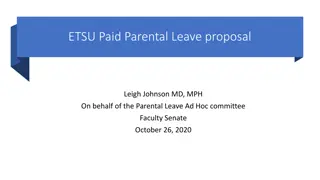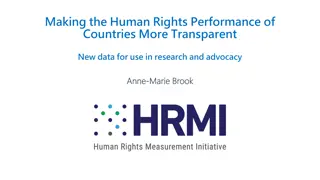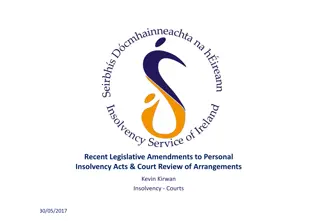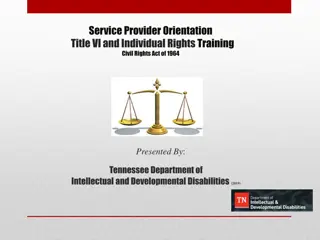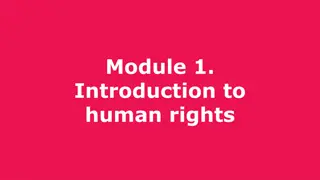
Understanding Creditors' Rights and Economic Conditions Post-COVID
Gain insights into creditors' rights and economic conditions post-COVID, with a focus on solvency tests, bankruptcy predictions, and the impact on businesses and the economy in 2020 and 2021. Explore the challenges faced by companies and the support provided through federal stimulus packages, along with an analysis of the market standpoint. Stay informed to navigate the evolving landscape effectively.
Download Presentation

Please find below an Image/Link to download the presentation.
The content on the website is provided AS IS for your information and personal use only. It may not be sold, licensed, or shared on other websites without obtaining consent from the author. If you encounter any issues during the download, it is possible that the publisher has removed the file from their server.
You are allowed to download the files provided on this website for personal or commercial use, subject to the condition that they are used lawfully. All files are the property of their respective owners.
The content on the website is provided AS IS for your information and personal use only. It may not be sold, licensed, or shared on other websites without obtaining consent from the author.
E N D
Presentation Transcript
CREDITORS RIGHTS: WHAT YOU NEED TO KNOW TO GET PAID September 20, 2021 NACA Annual Conference
Daniel C. Curth, Esq. Goldstein and McClintock, LLLP J. Bradley Sargent James M. Spencer CCA, CFE, CVA Sargent Consulting Group. LLC CPA/CFF/ABV, CFE, CFS, CCA, FABFA Sargent Consulting Group. LLC
AGENDA Lay of the Land: Economic Conditions Post-Covid 11 USC 548: Solvency Tests Reasonable Equivalent Value Solvency Tests Balance Sheet Test Cash Flows Test Adequate Capital Test Uniform Fraudulent Transfer Act History of UFTA Key UFTA Verbiage
LAY OF THE LAND: ECONOMIC CONDITIONS POST-COVID Bankruptcy Pros Expect Busy 2021 December 23, 2020 - The Wall Street Journal Relief aid has allowed many to delay a bankruptcy filing but that number could soar in 2021 once relief options expire. Epiqangle blog post Predictions for Bankruptcies in 2021
LAY OF THE LAND: ECONOMIC CONDITIONS POST-COVID it s difficult to overstate the level of disruption companies faced in 2020. The second round of federal stimulus approved in December 2020 will provide much-needed support to companies through the first half of 2021 PWC Turnaround and restructuring 2021 outlook I think that right now we are, to a large extent, in the eye of the hurricane. January 3, 2021 Marshall Huebner, co-head of Davis Polk & Wardwell s restructuring group (Thomson Reuters Westlaw Today )
LAY OF THE LAND: ECONOMIC CONDITIONS POST-COVID Compared to pre-pandemic levels, in 2020 the U.S.: Annual GDP decreased 3.5% Average unemployment rate was 8.1% The economy lost 9.4 million jobs 74% of small businesses reported negative impacts from COVID-19 The US trade deficit expanded to $679 billion (up 18% from 2019)
LAY OF THE LAND: ECONOMIC CONDITIONS POST-COVID From an Overall Market Standpoint (August 31, 2021) https://tradingeconomics.com/united-states/stock-market
LAY OF THE LAND: ECONOMIC CONDITIONS POST-COVID From a Covid Impact Standpoint (August 30, 2021) https://covid.cdc.gov/covid-data-tracker/#trends_dailytrendscases
LAY OF THE LAND: ECONOMIC CONDITIONS POST-COVID Nearly Every Industry Sector has been Negatively Impacted (74%) Nearly Every Industry Sector has Received Federal and/or State Support (73%) https://usafacts.org/state-of-the-union/economy
LAY OF THE LAND: ECONOMIC CONDITIONS POST-COVID Paycheck Protection Program ( PPP ) - $802 billion to date. - Nearly 12 million loans https://www.americanactionforum.org/r esearch/tracker-paycheck-protection- program-loans/
LAY OF THE LAND: ECONOMIC CONDITIONS POST-COVID Other Federal Programs: Small Business Association COVID-19 Economic Injury Disaster Loan ( EIDL ) Up to $500,000, 30-year loan available to meet financial obligations and operating expenses that could have been met had the disaster not occurred USDA Pandemic Assistance for Producers and Rural Manufacturing Long- term Loan Initiatives. Other programs such as Restaurant Revitalization Fund, Shuttered Venues Grant, and SBA existing debt relief
LAY OF THE LAND: ECONOMIC CONDITIONS POST-COVID
UNIFORM FRAUDULENT TRANSFER ACT UFTA Developed by the National Conference of Commissioners on Uniform State Laws in 1984 A revision of the Uniform Fraudulent Conveyance Act promulgated in 1918, as a result of significant law changes: Bankruptcy Reform Act of 1978 Uniform Commercial Code Creditors can void a debtor s transaction in two situations: When a debtor engages in a transaction with the intent to hinder, delay or defraud any creditor, When a debtor makes a transfer without receiving reasonably equivalent value under certain conditions.
11 USC 548: FRAUDULENT TRANSFERS AND OBLIGATIONS (a) (1) The trustee may avoid any transfer (including any transfer to or for the benefit of an insider under an employment contract) of an interest of the debtor in property, or any obligation (including any obligation to or for the benefit of an insider under an employment contract) incurred by the debtor, that was made or incurred on or within 2 years before the date of the filing of the petition, if the debtor voluntarily or involuntarily (A) made such transfer or incurred such obligation with actual intent to hinder, delay, or defraud any entity to which the debtor was or became, on or after the date that such transfer was made or such obligation was incurred, indebted; or (B) (i) received less than a reasonably equivalent value in exchange for such transfer or obligation; and (ii) (I) was insolvent on the date that such transfer was made or such obligation was incurred, or became insolvent as a result of such transfer or obligation; (II) was engaged in business or a transaction, or was about to engage in business or a transaction, for which any property remaining with the debtor was an unreasonably small capital; (III) intended to incur, or believed that the debtor would incur, debts that would be beyond the debtor s ability to pay as such debts matured; or (IV) made such transfer to or for the benefit of an insider, or incurred such obligation to or for the benefit of an insider, under an employment contract and not in the ordinary course of business.
UNIFORM VOIDABLE TRANSACTIONS ACT UVTA Developed by the Uniform Law Commission in 2014, but only enacted by 22 states, with two additional states pending Four main revisions to UFTA: Choice of law provision, laws in debtor s location governs the voidable transaction claim. Creditor must prove intent to hinder, delay or defraud by preponderance of evidence not clear and convincing evidence UVTA identifies series LLCs, and clarifies that transactions between a series and another series can be viewed as voidable Fraudulent is replaced with voidable as legal definition of fraud not required to be proven
REASONABLE EQUIVALENT VALUE Subjective and imprecise Value : Court must first decide on a reasonable valuation for each side of a transaction. Often simple for one side of transaction, e.g.: cash side Reasonable Equivalent : How much of a difference in value can be considered reasonably equivalent? 10%? 30%? Courts have typically considered reasonable equivalent value to have the same meaning as fair consideration Fair consideration: income, real or personal property, services, or support and maintenance equal to or exceeding the fair market value of the income or resources that were transferred. Fair market value: Price paid in an arm's length transaction between a willing buyer and a willing seller
BALANCE SHEET TEST The balance sheet test determines whether the total fair value of the debtor assets is greater than the total amount of the debtor liabilities. Assets are adjusted from the book value by assuming the assets are at their highest and best use and the debtor is a going concern. U.S. Generally Accepted Accounting Principles (GAAP) define fair value as the price that would be received to sell an asset or paid to transfer a liability in an orderly transaction between market participants at the measurement date. Fair value of the assets is determined by calculating the fair value of invested capital ( FVIC ), which equals equity plus interest-bearing debt, and then adding non-interest-bearing debt. DOES THE ENTITY HAVE POSITIVE EQUITY?
BALANCE SHEET TEST Per Books: Recalculated:
CASH FLOW TEST The cash flow test determines the debtor s ability to meet its obligations as they become due. Cash flows and debt obligations are projected over a period that correlates to the repayment period for long-term debt or a specific loan typically multi-year. Available cash is calculated as the sum of 1) excess available cash at the beginning of the period 2) cash flow during the period and 3) unused and available credit commitments. HOW MUCH CASH IS AVAILABLE TO DEBT AND EQUITY HOLDERS?
ADEQUATE CAPITAL TEST The adequate capital test determines whether the debtor has adequate capital to meet its operating expenses, capital expenditures and debt repayment obligations for a specific period, typically one year. DOES THE ENTITY HAVE THE CAPITAL TO OPERATE THE BUSINESS FOR ONE YEAR?
CONTACT INFO Dan Curth Email: danc@goldmclaw.com Phone: 312.337.7700 Brad Sargent Email: bsargent@scgforensics.com Phone: 708.390.7445 Jim Spencer Email: jspencer@scgforensics.com Phone: 708.390.7400


